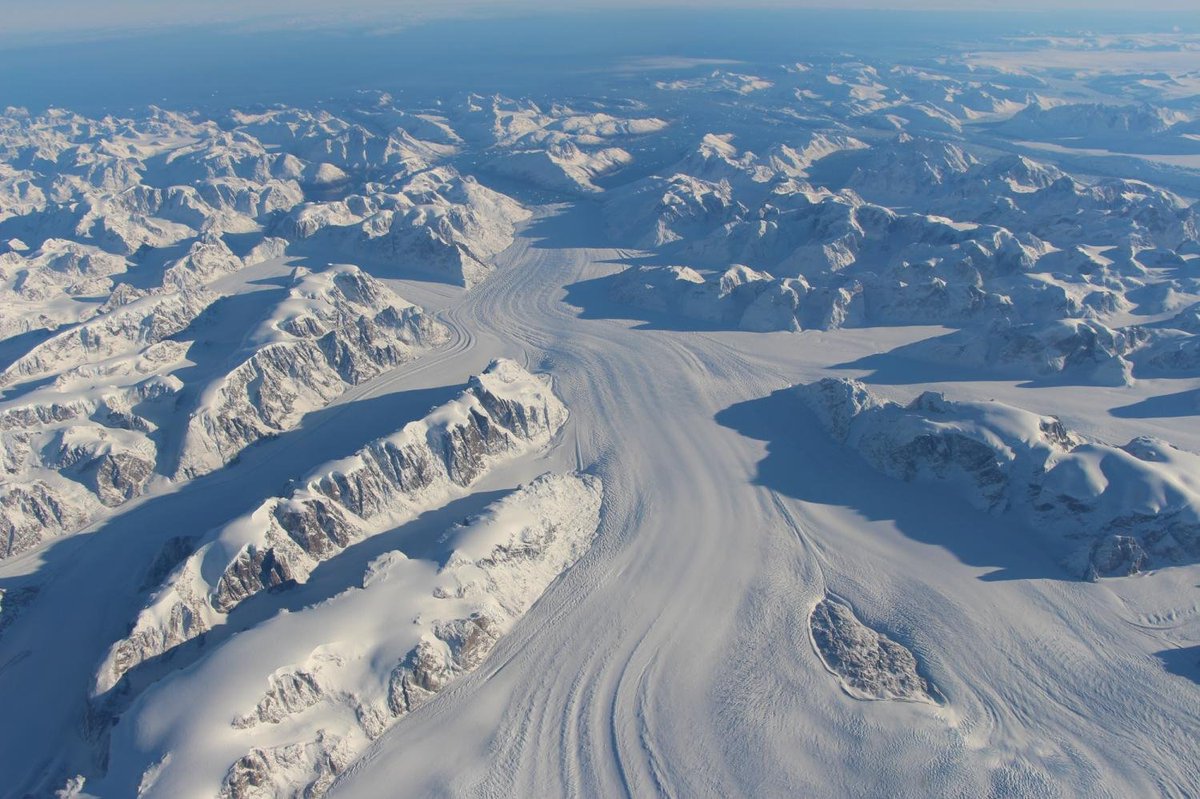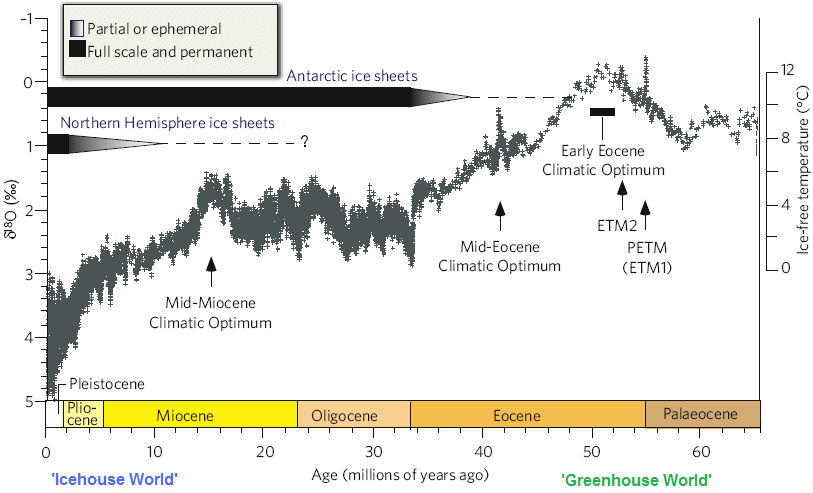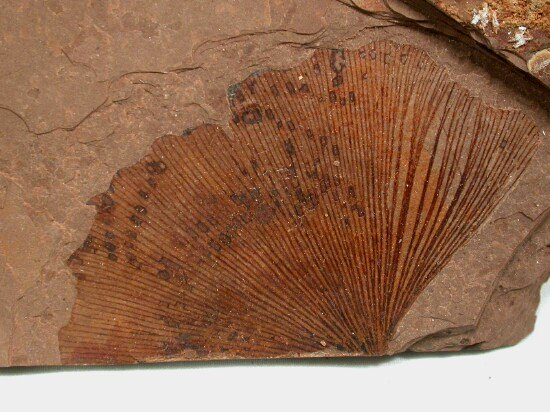
One (very important) topic I didn't get to address in this story is: how do we know what the temperature, or the co2 level in the atmosphere was millions of years ago? 1/x
https://twitter.com/PeterBrannen1/status/1357429391312101376
Continuous ice core records from Antarctica & Greenland are great. They contain trapped pockets of air containing ancient CO2, & the ice can be geochemically analyzed to reconstruct temps. But they "only" go back 800,000 years. (efforts are underway to retrieve older ice cores) 



Beyond that, you need different proxies. And that's where the most important organism in paleoclimate research comes in: foramenifera.
https://twitter.com/peterbrannen1/status/1120762637514493957?lang=en
Forams are single-celled organisms that live in the ocean and build their shells out of calcium carbonate. In doing so, they record the chemistry of the seawater around them. 

As it happens, water contains oxygen (H₂O). And oxygen on Earth mostly comes in two varieties, a heavier & lighter isotope: ¹⁸O and ¹⁶O (There's also some ¹⁷O but don't worry about it). The abundances of different oxygen (and hydrogen) isotopes in seawater can tell us a lot.
Water made more out of light isotopes is literally lighter, & so evaporates more easily. Ice sheets, which are made of snow that once evaporated as water from the ocean, are made out of this lighter water. 

If more and more of this lighter water gets deposited on the land as ice sheets it leaves behind heavier water in the ocean. Forams record this change. What's amazing is by looking at ratio of ¹⁶O:¹⁸O in foram shells you can reconstruct how much ice there is elsewhere on planet 

But the temperature of the seawater (and other ocean chemistry) also affects this ratio. So, using all this info, you can reconstruct the global temperature as well. And luckily, we have deep-sea sediment cores filled with fossil forams going back over a hundred million years 

Paleoceanographers using these sediment cores have thus reconstructed the ancient planet. For ex. Lorraine Lisiecki & Maureen Raymo showed rapid swings btw glacial/interglacial climates over the past 5.3M yrs. And James Zachos et al. charted temps over entire 66M yr Cenozoic Era 



Additional proxies, like the ratio of magnesium to calcium in foram shells, provide temperature estimate when the presence of ice sheets on the planet complicates this isotope picture.
And biology gives other clues to the global climate. These are pictures I took of the Smithsonian's Scott Wing looking for 53 million year-old fossil leaves from the ancient jungles of Wyoming. He's interested in the leaves because... 



Smooth-margined leaves are characteristic of warmer tropical climates, whereas toothed edges on leaves are a physiological adaptation to cooler climates. Reconstruct enough local ancient climates and you get a pretty good idea of what the world was like. uwyodioramas.wordpress.com/2013/02/26/res… 

Ancient fossil lipids, once-upon-a-time synthesized by phytoplankton found in seafloor sediments are another paleo-thermometer. In response to warmer water some organisms produce more saturated fats, when it's colder, more unsaturated fats sciencedirect.com/science/articl… 

And then there are the animals. Find fossil skeletons of alligators on the northernmost islands of arctic Canada, as you do from 50 million years ago (when continents were in similar positions) & it's pretty good indication that the planet was really warm.
Paleontologist Jaelyn Eberle, who has worked on this ancient fauna, told me that a modeler once asked her if she could "put hair on her arctic alligators" as climate modeling community had long struggled to reproduce world as warm as her fossils suggested
https://twitter.com/PeterBrannen1/status/1026587486485667840
What about CO2? Again the remnants of ancient biology help paleoclimatologists reconstruct the planet's climate over Earth history. Plants reduce the number of pores on their surface to conserve water as CO2 rises. In high CO2 climates fossil leaves, like Gingko, have fewer pores 

And from deep-sea sediment cores again, long chain molecules of organic carbon made by ancient life ends up in deep-sea floor muck. Just like oxygen there are lighter & heavier isotopes of C, and photosynthesizers prefer the lighter stuff, but can't be as choosy when CO2 is low. 

And the chemistry of elements like boron in seawater responds to the pH of the ocean, which is itself a function of CO2. Once again, forams from deep-sea sediment cores record these ancient ocean chemistry changes. paleo-co2.org/proxiesBoron
And the presence of minerals in the rock record that can't form at Earth's surface today can also tell you whether atmospheric CO2 was above some threshold in the ancient past.
https://twitter.com/PeterBrannen1/status/1351245539027902465
There are countless other proxies, and paleoclimatologists are constantly developing new ones, applying them to samples that have been arduously collected by thousands of scientists, over decades of geological fieldwork and deep-sea drilling projects like the @TheJR 

No proxy is perfect, and there are complications and uncertainties around each of them but...
Together all these records give us a compelling and, I would argue, cautionary story about the climate's history over tens of millions of years (illustrated beautifully in this recent @leafwax paper science.sciencemag.org/content/370/65…).
When CO2 has been high, it has been VERY warm. End.
When CO2 has been high, it has been VERY warm. End.

Addendum: Just remembered the wildest temp proxy. Snake size. Titanoboa was *preposterously* large snake that lived 60 million years ago. The paleontologists who discovered it argue that--due to snake physiology--it could only exist on a MUCH warmer world nature.com/articles/natur… 

• • •
Missing some Tweet in this thread? You can try to
force a refresh












